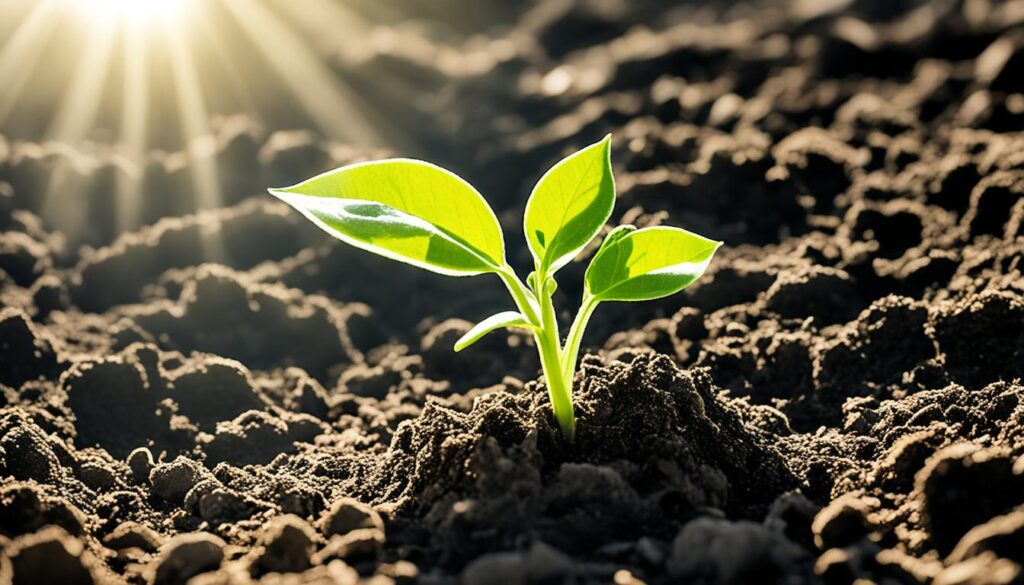“No one saves us but ourselves. No one can and no one may. We ourselves must walk the path.” – Buddha
Healing from childhood trauma is a profound and courageous journey that requires your active participation. It is a path of overcoming past pain, embracing vulnerability, and nurturing your inner child. The emotional healing journey offers an opportunity to transform the wounds of the past into sources of strength, resilience, and personal liberation.
Throughout this article, we will explore the transformative process of healing childhood trauma and the vital role it plays in shaping your present and future. From understanding the peaks and valleys of healing to reconnecting with your inner child, we will delve into the essential steps of the trauma recovery process. By embracing this journey, you have the power to unlock emotional freedom and create a life filled with healing, growth, and empowerment.
Key Takeaways:
- Healing childhood trauma is a personal journey that requires self-empowerment and active participation.
- Overcoming past pain and nurturing your inner child are essential aspects of the healing journey.
- The trauma recovery process is characterized by peaks and valleys, and setbacks are a natural part of the healing process.
- Reconnecting with your inner child and shedding layers of conditioning are crucial for unlocking emotional healing.
- By integrating your past experiences into the present, you can achieve holistic healing and personal transformation.
The Unveiling of Traumas and the Peaks and Valleys of Healing
The healing journey often begins with the unveiling of past traumas, a deep exploration of one’s painful experiences that sets the stage for healing. Traumas can resurface unexpectedly, surfacing memories and emotions that have long been buried. This revelation acts as a catalyst, initiating the transformative path of healing childhood trauma.
The healing journey, however, is not a linear process. It is marked by peaks and valleys, highs and lows, where progress fluctuates and setbacks can occur. It is essential to acknowledge and embrace both the triumphs and the challenges that come with healing. Each peak represents a step forward, a moment of growth, and empowerment. Every valley, on the other hand, offers an opportunity for self-reflection, acceptance, and the cultivation of resilience.
During the peaks, you may experience newfound clarity, liberation, and a sense of lightness as you release the weight of your past. It is a time for celebrating milestones, acknowledging progress, and recognizing the strength within you. Remember to appreciate and honor your achievements, no matter how small they may seem.
Conversely, the valleys in your healing journey may present moments of doubt, pain, and resistance. Setbacks in the healing process are natural and should not be seen as signs of failure. Instead, view them as opportunities for learning, compassion, and growth. Embrace the valleys as integral parts of your healing journey, for it is through navigating these challenges that you gain invaluable insights and resilience.
Just as nature experiences seasons of growth, transformation, and dormancy, your healing journey is, too, composed of different seasons. Understand that healing is not a destination but an ongoing process. Each peak and valley contributes to your overall growth and strength, shaping you into the person you are becoming.
| Peaks of Healing Journey | Valleys of Healing Journey |
|---|---|
| Celebration of milestones and accomplishments | Moments of doubt, pain, and resistance |
| A newfound sense of clarity and liberation | Opportunities for self-reflection and growth |
| Increased resilience and strength | Challenges that cultivate compassion and empathy |
Remember, the healing journey is unique for everyone. Embrace the peaks and valleys of your healing process, knowing that setbacks are not setbacks at all but crucial components of transformation and growth.
Reconnecting with the Inner Child and Shedding Layers of Conditioning
As you embark on your healing journey, it is essential to reconnect with your inner child. Your inner child carries the imprints of past trauma, and nurturing this wounded part of yourself is a crucial step towards healing. Reconnecting with your inner child means acknowledging their pain, fears, and needs, and extending compassion, understanding, and love towards them.
Creating a sense of safety and security for your inner child is vital. Imagine yourself as a loving and nurturing parent, providing a nurturing environment where your inner child feels safe to express themselves authentically. This process allows you to acknowledge their experiences, validate their emotions, and rebuild trust within yourself.
Healing also involves shedding layers of conditioning imposed by traumatic experiences. Shedding these layers of conditioning means letting go of the beliefs, behaviors, and coping mechanisms that were developed as a response to the trauma. It is a process of unraveling the external influences that have shaped your sense of self and rediscovering your authentic self beneath the weight of past wounds.
The Wounded Inner Child: A Journey of Nurturing
Your wounded inner child requires consistent and ongoing nurturing. Just as a wounded child needs gentle care and attention, you must provide the same for your inner child. This involves actively listening to their needs, acknowledging their pain, and providing the comfort and support they lacked during the traumatic experiences.
By nurturing your wounded inner child, you create a foundation for healing and growth. This nurturing process allows you to build a sense of trust, self-compassion, and self-love. It enables you to tend to the unmet needs of your inner child and create an inner environment that fosters healing and transformation.
As you reconnect with your inner child and shed layers of conditioning, you will begin to uncover the authentic essence of who you are. The healing journey is a process of peeling back the layers, revealing the vibrant, resilient, and whole self that resides beneath.

Integration of Past and Present for Holistic Healing
A transformative healing journey involves the integration of past experiences into the present. By acknowledging and understanding the past, you can navigate the present with clarity and intention. This integration allows for a holistic approach to healing, recognizing the impact of trauma on various aspects of life such as relationships, emotions, and behaviors.
When we acknowledge and understand the past, we bring awareness to how it shapes our present experiences. The integration of past and present gives us the opportunity to heal and find a sense of wholeness. It opens the door for growth, personal evolution, and a deeper understanding of ourselves.
Integrating the past and present involves recognizing the ways in which trauma has influenced our lives. It requires us to examine our beliefs, patterns, and reactions that stem from past experiences. This process allows us to make conscious choices in the present, breaking free from the limitations that may have been imposed by our past.
Through integration, we gain valuable insights into ourselves and our relationships. It enables us to heal wounds that may have affected the way we connect with others, express our emotions, and navigate the world. Integration is not about erasing or forgetting the past, but rather about finding healing and growth through the integration of our experiences.
To illustrate the impact of trauma on various aspects of life, consider the following table:
| Aspect of Life | Impact of Trauma |
|---|---|
| Relationships | Difficulty trusting others, fear of abandonment, challenges in intimacy |
| Emotions | Emotional dysregulation, difficulty managing anger or sadness |
| Behaviors | Self-destructive behaviors, avoidance, self-isolation |

As you can see from the table above, trauma can have a profound impact on various aspects of our lives. Understanding these effects and integrating them into our present experiences is crucial for holistic healing.
The journey of integration is unique for each individual and requires time, patience, and support. It is an opportunity to honor your past, make peace with it, and create a foundation for a more fulfilling and empowered present. By integrating your past and present, you can embark on a transformative healing journey towards emotional freedom and a more authentic existence.
Embracing Growth and Transformation on the Healing Journey
Growth and transformation are inherent to the healing journey. As you embark on the path of healing childhood trauma, you open yourself up to a world of personal evolution and self-discovery. Healing is not a quick fix or a one-time event; it is a continuous process that unfolds over time.
By embracing growth and transformation, you empower yourself to cultivate resilience, patience, and a deep understanding of who you are. The healing journey is not about erasing or forgetting the past, but rather integrating it into your present self. As the layers of pain and conditioning shed away, you uncover your authentic essence.

Just like a flower that blooms after a long winter, your healing journey allows you to blossom into a fuller, more authentic, and empowered existence. It is a journey that embraces every aspect of your being, ensuring that you grow not only outwardly but inwardly as well.
Embracing Resilience
Resilience is the ability to bounce back from adversity and adapt to challenging circumstances. It is a quality that you cultivate along your healing journey. By facing your past traumas head-on, you develop resilience that helps you overcome future obstacles with strength and determination.
Fostering Patience
Healing is a gradual process that requires patience. It is not a race, but a journey that unfolds at its own pace. Along the way, you learn to be patient with yourself, allowing the wounds to heal and the transformation to occur naturally. Patience is a virtue that nurtures your healing journey and encourages self-compassion.
Discovering Your Authentic Self
As you navigate the healing journey, you uncover layers of conditioning imposed by past trauma. By letting go of these layers, you rediscover your authentic self—the essence of who you truly are. The process of self-discovery is liberating, allowing you to tap into your unique strengths and passions.
Embracing growth and transformation on your healing journey is not always easy, but it is worth every step. Through resilience, patience, and self-discovery, you evolve into the best version of yourself. You become an inspiration to others, showing them that healing from childhood trauma is possible.
| Growth and Transformation | Benefits |
|---|---|
| Personal Evolution | Uncover your true identity and purpose |
| Self-Discovery | Tap into your unique strengths and passions |
| Resilience | Bounce back from adversity and adapt to challenges |
| Patience | Develop the ability to wait and trust the healing process |
The Hero’s Journey: Using Mythology as a Framework for Healing
The healing journey can be likened to the hero’s journey, a powerful framework derived from mythology. Just as the hero embarks on a transformative quest to overcome challenges and achieve personal growth, individuals on their healing journey face similar trials and triumphs. By understanding and embracing the hero’s journey archetype, one can find inspiration and guidance for their own trauma recovery process.
Like the hero, the healing journey begins with initiation, a call to embark on a path of healing and transformation. This call may come in the form of a newfound awareness or a desire for change. It is a pivotal moment that sets the stage for the journey ahead.
As the hero confronts change, so do individuals on their healing journey. Confronting past traumas, wounds, and limiting beliefs requires courage and a willingness to face the discomfort. This journey demands inner strength and a commitment to growth, much like the hero’s confrontation with adversity.
Throughout the hero’s journey, there is a process of maturing and self-discovery. Similarly, the healing journey involves uncovering deeper layers of oneself and rediscovering one’s authentic self. It is a process of shedding past conditioning, societal expectations, and the weight of trauma, allowing the true essence to emerge and flourish.
Just as the hero’s journey is not without its hurdles and setbacks, the healing journey also presents challenges along the way. It is important to remember that setbacks are part of the process and do not define the journey. The hero’s resilience and determination to persevere can inspire individuals on their healing journey to keep going despite obstacles.
Comparing the Hero’s Journey and the Healing Journey
| The Hero’s Journey | The Healing Journey |
|---|---|
| Initiation | Initiation into the healing journey, a call to embark on the path of healing. |
| Confrontation of Change | Confronting past traumas, wounds, and limiting beliefs. |
| Maturing and Self-Discovery | Uncovering deeper layers of oneself and rediscovering authenticity. |
| Trials and Setbacks | Facing challenges and setbacks along the healing journey. |
| Triumph and Transformation | Achieving personal growth and transformation through healing. |

By recognizing the parallels between the hero’s journey and the healing journey, individuals can find solace, inspiration, and a roadmap for their own trauma recovery. Myths and stories from various cultures have long been used to convey profound truths and universal human experiences. They offer guidance, archetypal symbolism, and a sense of collective wisdom that can support individuals as they navigate their healing journey. Embrace the hero archetype within yourself and embark on the transformative journey towards healing.
Conclusion
Embarking on the journey of healing childhood trauma is a transformative and empowering experience. By embracing this journey, you have the opportunity to find emotional freedom and create a more fulfilling life. Throughout this transformative journey, you will encounter the unveiling of past traumas, navigate the peaks and valleys of healing, reconnect with your inner child, integrate past experiences into the present, and embrace personal growth and transformation.
It is important to approach this healing journey with resilience, patience, and a commitment to self-discovery. By doing so, you can break free from the shackles of your past and create a brighter future. Remember, healing is not a linear process, but a continuous evolution towards emotional freedom and a more authentic existence.
As you embark on your healing journey, consider using the power of mythological storytelling as a framework for understanding and navigating the healing process. Draw inspiration from the hero’s journey, where challenges are overcome and personal growth is achieved. By embracing this powerful narrative, you can find guidance and strength along your path to healing.
Are you ready to embrace the transformative power of healing childhood trauma? Start your journey today, nurture your inner child, and unlock the emotional freedom that awaits you. With resilience, patience, and a commitment to self-discovery, you can break free from the chains of the past and embark on a transformative journey towards a fuller and empowered existence.

